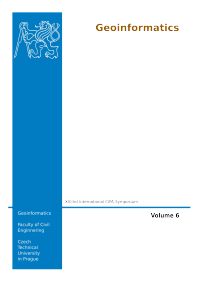New Sensors for Cultural Heritage Metric Survey: The ToF Cameras
DOI:
https://doi.org/10.14311/gi.6.38Keywords:
Time-of-Flight, RIM, calibration, metric survey, 3D modelingAbstract
ToF cameras are new instruments based on CCD/CMOS sensors which measure distances instead of radiometry. The resulting point clouds show the same properties (both in terms of accuracy and resolution) of the point clouds acquired by means of traditional LiDAR devices. ToF cameras are cheap instruments (less than 10.000 €) based on video real time distance measurements and can represent an interesting alternative to the more expensive LiDAR instruments. In addition, the limited weight and dimensions of ToF cameras allow a reduction of some practical problems such as transportation and on-site management. Most of the commercial ToF cameras use the phase-shift method to measure distances. Due to the use of only one wavelength, most of them have limited range of application (usually about 5 or 10 m). After a brief description of the main characteristics of these instruments, this paper explains and comments the results of the first experimental applications of ToF cameras in Cultural Heritage 3D metric survey. The possibility to acquire more than 30 frames/s and future developments of these devices in terms of use of more than one wavelength to overcome the ambiguity problem allow to foresee new interesting applications.References
ähne, B., Haubecker, H., Geibler, P.: Handbook of Computer Vision and Applications. Academic Press, 1999.
Rinaudo, F., Chiabrando, F., Nex, F., Piatti, D.: New instruments and technologies for Cultural Heritage survey: full integration between point clouds and digital photogrammetry, Proceedings of the Third International Conference, EuroMed 2010, Lemessos (CY) November 8-13, 2010, 56- 70.
Chiabrando, F., Piatti, D., Rinaudo, F.: SR-4000 TOF camera: further experimental tests and first applications to metric survey, ISPRS proceedings, Vol. XXXVIII/5, Commission V Symposium, Newcastle upon Tyne (UK), 2010, 149-154.
Scherer, M.: The 3D-ToF-Camera as an innovative and low-cost tool for recording, surveying and visualization – a short draft and some first experiences, Proceedings of CIPA Symposium, Kyoto, Japan, 2009.
Albota, M.A., Heinrichs, R.M., Kocher, D.G., Fouche, D.G., Player, B.E., Obrien, M.E., Aull, G.F., Zayhowski, J.J., Mooney, J., Willard, B.C., Carlson, R.R: Three-dimensional imaging laser radar with a photon-counting avalanche photodiode array and microchip laser, Appl. Opt. (2002) 41, 7671-7678.
Rochas, A., Gösch, M., Serov, A., Besse, P.A., Popovic, R.S: First Fully Integrated 2-D Array of Single-Photon Detectors in Standard CMOS Technology, IEEE Photonic. Technol. Lett. 2003, 15, 963-965.
Gvili, R., Kaplan, A., Ofek E., Yahav, G, Depth keying, Proceedings of SPIE Electronic Imaging, vol. 5249, 2003, 534-545.
Lange, R., 3D Time-of-Flight distance measurement with custom solid state image sensors in CMOS/CCDtechnology. Ph.D. Thesis, University of Siegen (Germany), 2000.
http://canesta.com/ (accessed on May 2011).
http://www.mesa-imaging.ch/ (accessed on May 2011).
http://www.pmdtec.com/ (accessed on May 2011).
http://www.advancedscientificconcepts.com/ (accessed on May 2011).
Piatti, D.: Time-of-Flight cameras: test, calibration and multi-frame registration for automatic 3D object reconstruction. PhD thesis, Politecnico di Torino (Italy), 2011.
Rousseeuw, P.J., Leroy, A.M.: Robust Regression and Outlier Detection, Wiley Series in Probability and Mathematical Statistics, Wiley, New York, USA, 1987.
Bay, H., Ess, A., Tuytelaars, T., Gool, L.V., SURF: Speeded Up Robust Features, Computer Vision and Image Understanding (CVIU), Vol. 110 (3), 2008, 346-359.
Downloads
Published
Issue
Section
License
- Authors retain copyright and grant the journal right of first publication with the work simultaneously licensed under a Creative Commons Attribution License that allows others to share the work with an acknowledgement of the work's authorship and initial publication in this journal.
- Authors are able to enter into separate, additional contractual arrangements for the non-exclusive distribution of the journal's published version of the work (e.g., post it to an institutional repository or publish it in a book), with an acknowledgement of its initial publication in this journal.
- Authors are permitted and encouraged to post their work online (e.g., in institutional repositories or on their website) prior to and during the submission process, as it can lead to productive exchanges, as well as earlier and greater citation of published work (See The Effect of Open Access).

